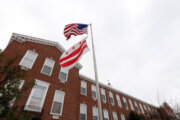GRAND CANYON NATIONAL PARK, Ariz. (AP) — Sharon Ellison and Fred Jernigan spent four days hiking and camping from one end of the Grand Canyon to the other, with plans to relax at a hotel within the park on Thursday. But when they reemerged from the jagged canyon at the South Rim, they soon learned they were without accommodations for the night.
A series of breaks in the Grand Canyon’s only water pipeline prompted park officials to take unprecedented action with what they call “Stage 4” water restrictions, forcing the sudden shutdown of overnight hotel stays during one of the busiest times of the year.
“It’s a precious resource, and we understand that,” Jernigan said Thursday morning. “It’s not really a shock to us.”
Since July 8, the park has faced challenges with its water supply and has been implementing various levels of water restrictions. Now, officials said, no water is currently being pumped to the canyon’s south or north rims.
The 12.5 mile-long (20 kilometer-long) Transcanyon Waterline, originally built in the 1960s, supplies potable water for facilities on the South Rim and inner canyon. Park officials say it has exceeded its expected lifespan.
Under the current water restrictions, visitors won’t be able to stay overnight starting Thursday, including at the El Tovar Hotel, Bright Angel Lodge, Phantom Ranch and Maswik Lodge, where Jernigan and Ellison had booked a room for the night.
The North Carolina residents haven’t showered since Sunday, and they will have to find a new place to sleep Thursday night. But “after coming up rim to rim, we can roll with the punches,” Ellison said, laughing.
Hotels outside the park in the nearby town of Tusayan, as well as the North Rim’s Grand Canyon Lodge will remain open. The park will stay open during the day, and visitors still have the option to camp, as did Barbara Badger, who was visiting for two nights from Fontana, California.
Badger said she decided a few weeks ago to spend the first anniversary of her husband’s death at the Grand Canyon, a spot they visited together.
“We loved it. He loved it so much,” Badger said, tearing as she spoke of her late husband, Douglas.
Even though they didn’t hike or camp during their visit together, she said a voice in her head told her to get a sleeping bag and other gear.
“So I did all of that and, when I got here, I was prepared to camp out and with no reason why,” she said. “Except that’s just the way it worked.”
Carved by the Colorado River and known for its vast desert landscapes, the Grand Canyon welcomed nearly 523,000 visitors last August and more than 466,000 visitors last September.
At Yavapai Lodge, about 970 reservations for the weekend were canceled, according to spokesperson Glen White. Guests will be refunded for all deposits and payments, he said.
A spokesperson for Xanterra Travel Collection, which operates other affected hotels and lodging inside the park, didn’t respond to a request for comment.
Park officials hope to make repairs and welcome back overnight guests on the South Rim as quickly as possible. But restoration efforts won’t be easy for an aluminum pipe that isn’t insulated and sits above the ground near hiking trails in some areas.
“Here, to be exposed to the elements, that brings in a whole new level of complexity,” said Darren Olson, who chairs the American Society of Civil Engineers’ Committee on America’s Infrastructure. He pointed to potential rock slides and extreme heat.
Since 2010, more than 85 major breaks have disrupted water delivery, but none have forced Stage 4 water restrictions. That is, until four recent significant breaks.
Park officials say the damage occurred down in the depths of the canyon in a narrow area known as “the box” that is highly susceptible to rock fall and dangerous heat this time of the year. A photo of one of the recent breaks released by officials shows the pipe spitting out a funnel of water across the slim canyon.
“You’re having to put in a water main providing services that we all take for granted, but you’re providing it in locations where, really, mother nature wasn’t meant to have fresh water delivered there,” Olson said. “It makes for a challenge.”
The pipeline issues continued as park officials on Thursday announced what is believed to be the sixth fatality at the canyon in a month and the 14th this year. They said a 60-year-old man from North Carolina who was backpacking alone was found dead Wednesday morning on a remote trail.
Other fatalities included a 33-year-old woman who was swept away last week in a flash flood while on a hiking trip, and another North Carolina man who fell to his death July 31 at the South Rim.
___
Yamat reported from Las Vegas.
Copyright © 2025 The Associated Press. All rights reserved. This material may not be published, broadcast, written or redistributed.









